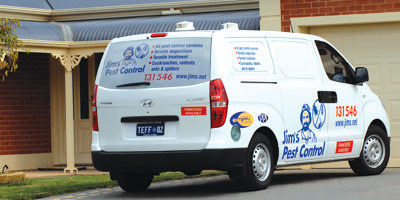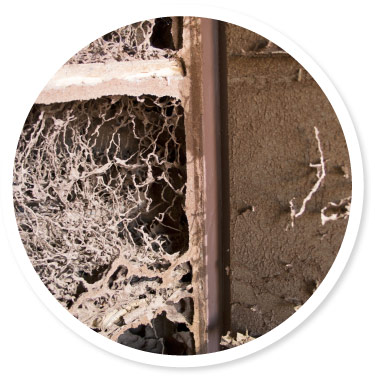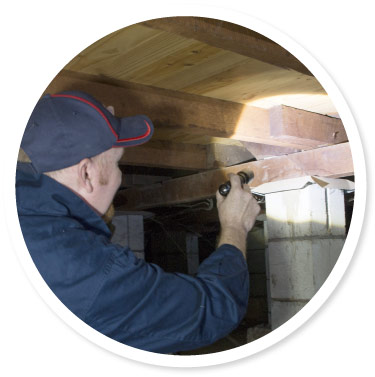Being vigilant for signs of termites in Albury is very important to both home owners & commercial building owners.
Annually, termites in Australia cause 3-4 billion dollars in damage to Australian properties. Signs of termite infestations may be difficult to find or be clearly visible, depending on the infestation.
Ask your local Jim’s Termite and Pest Control technician for a termite inspection in Albury today on 131 546.
Signs of termites include:
- Inflated and brittle timber
- Creaking and wavy timber floor boards
- Mud leads running along timber or up other surfaces leading to timber
- Small flight holes with Elates exiting them
- Mounds on ground or base of tree stump

Termite Background
Activity involving termites often goes unnoticed or until structural failure occurs, however regular inspections by our licensed technicians will ensure security and peace of mind.
Within Australia, the most common termites found in the East are:
Coptotermes Frenchi
A subterranean forest termite that attacks living trees, causing considerable damage. This species is found throughout most of Eastern Australia, particularly within Victoria, Australian Capital Territory and New South Wales.
It is responsible for extensive damage to buildings, resulting in large repair costs at the expense of home and business owners. This species nests are found in the root crown or lower trunk area of living trees, particularly eucalyptus trees.
However, this species is often found building mounds in Southern Areas of Australia including New South Wales and Victoria.
Coptotermes Acinaciformis
This subterranean species is present throughout the entirety of the Australian mainland. This is the most destructive species of Termite in Australia, as it attacks all timber structures and damages forest ornamental trees such as fruit trees.
The nests of this species are mostly located in trees, stumps, poles or filled-in timber verandahs where timber has been buried. This species favours English Oak trees, Eucalyptus trees and Peppercorns, with the colonies found within the roots or lower stump of the trees.
Nasutitermes Exitiosus
A subterranean termite located throughout Southern Australia. This species attacks wood in the ground and also sound wood in buildings. If undetected severe damage may be incurred to homes and businesses.
However, due to their habit of constructing termite mounds within vicinities of infestation, control is generally easier than that of Coptotermes. This species constructs low mounds, with heights of 30-75cm and diameters of 20-120cm.
Within New South Wales and Victoria this species has been known to construct underground nests, leaving in some cases a bare patch of ground that may allude to its presence.
Such nests are often found under houses, where they may be undetectable until flooring collapses or their shelter tubes are seen.

What to look for:
Termite Shelter Tubes/Leads
These are the most commonly sighted first indicators of subterranean termite infestation, often found throughout subfloors of buildings on peers.
These tubes are easily recognizable, as they are mud-like tubes constructed and used by termites to bridge themselves across open areas without suffering exposure to light, varying temperatures and humidity. These tubes vary considerably in size, colour, length and thickness.
All are generally characterized by a light to dark brown colour with a mix of soil and digested timber exterior. If cracked open, such tubes are exploratory in nature, with interior cavities, that may contain active worker termites and soldiers moving in various directions.
Termite Earthen Workings
Such workings are similarly composed of the same material as that of the shelter tubes. These workings are often found throughout damaged timbers, between slabs or between timbers in subfloors.
These workings are characterised by a friable honeycomb-like design, sometimes referred to as ‘sub-nests’. These ‘sub-nests’ are however, more often than not, actually subsidiary or primary nests.
Termite Damaged Timber
The extent of damage to buildings vary greatly. In spotting significant termite damaged timbers, one must look for ripples, brittleness, and fragility of timber.
Depending on the breed of the termite may further determine the level of expected damage. Species such as the Nasutitermes Eitious will commonly create clean excavations within the timber, leaving little more than plaster-like workings separating their workings from the adjacent environments.
Subterranean Tunnels
Subterranean species of termites construct tunnels throughout the first 20cm of soil below ground. Timber resting in or on ground are attacked by termites through such tunnels, as they radiate outwards of the termite nests of distances up to 50m, and in some soils may be deeper and radiate further.
These tunnels are much the same as Termite Shelter Tubes in make, although are often thicker, with greater termite activity.
Termite Noises
In some cases, termite feeding, and activity may be heard in serious infestations. This is particularly apparent for Coptotermes Acinaciformis, where serious infestation sounds may be described as audible tapping sounds.
This tapping sound is created through the soldier termites tapping their heads and mandibles on the wood. The tapping likely signalling to others in the colony that there is a danger.
Termite Alates (Winged Reproductives)
The emergence of Alates colonizing flights are a very useful indicator as to the whereabouts of a colony. In the event of Alates swarming within a building, likely through blow holes in the interior timbers, it is likely that the nest is either below or in the wall cavity of the building. This may further indicate a serious infestation to the building.
This is because nests are located within 5 meters of where Alates emerge from. Furthermore, Alates may also emerge through blow holes, trees, stumps, poles, posts, or in some cases the ground, indicating a nest.
Termite Nests
In more sparsely populated areas where individual property sizes are large, there is greater risk of successfully locating nests than in built up areas.
Termite nests are characterized by mounds, large and small, with hard exteriors made of mud, clay and digested timber excrement.
They may be found in the open, underground, in trees, and in the base of trees. Upon penetrating a termite nest, honeycomb workings much like the termite earthen workings may be observed, however are often less friable, with larger air spaces and a more concentric pattern of the honeycombing than that of termite earthen workings.

